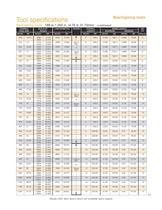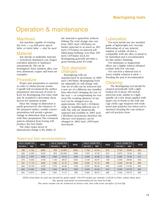
Catalog excerpts

Cogsdill Tool Products, Inc. Bearingizing tools The Bearingizing Tool combines roller burnishing with peening action. As the tool is rotated at a high speed the rolls spin, rise, and fall over a cammed arbor, delivering up to 200,000 rapid fire blows per minute to the work surface. The peaks and valleys of the machined surface are compacted into a smooth, hardened, and ultrafine The Bearingizer may be the tool of choice where the following conditions exist: ■ Parts with thin walls — Bearingizing eliminates barrel-shaping of the part. ■ surface finish. Parts with irregular wall thicknesses — the Bearingizing tool will produce a very round hole, whereas the Roll-a-Finish® tool might generate a slightly egg-shaped hole, due to variations in wall thickness. ■ ■ Applications where porosity is an issue (e.g., oil-impregnated bearings) — the smaller “footprint” of the Bearingizing roll leaves pores in the surface intact. Applications where very tight tolerances must be held — the Bearingizer reduces springback in the work surface material. The Bearingizing tool can, in some materials and with proper part preparation, hold size as close as ±.0001 inch (.002mm), while the Roll-a-Finish tool can achieve tolerances of ±.00025 inch (.006mm). Where the above conditions do not exist, the Roll-a-Finish® tool would generally be the tool of choice, for two reasons: (1) the relatively wide adjustment range of the Roll-a-Finish tool, which is typically .040 inch (1.01mm), and (2) the ease of adjustment, with the castellated adjusting collar on the Roll-a-Finish tool. The Bearingizing tool features a greater number of rolls, and rolls of a smaller diameter, as compared to the Roll-a-Finish tool, and can only be adjusted by change of rolls. The Bearingizer also requires a closer presize than the Roll-a-Finish tool. But where the above conditions do exist, the Bearingizing tool should be considered. While the Roll-a-Finish Tool increases surface hardness by about 5 to 10%, Bearingizing increases hardness by 10 to 30%, but with less surface penetration. 15
Open the catalog to page 1
Tool specifications Bearingizing Tools .188 to 1.250 in. (4.76 to 31.75mm) continued Bearingizing tools Shanks other than shown above are available upon request.
Open the catalog to page 3
Bearingizing tools Selection & ordering information To select a tool for the part and material to be Bearingized, determine the proper tool build-up. The build-up is the effective tool diameter required to produce a certain size in a given material. It is measured with the rolls diametrically opposed on the high surfaces of the cam. The build-up is equal to the maximum finished hole diameter plus a spring-back allowance — see chart. The maximum diameter (high side of tolerance) is used to allow for tool wear and still maintain part size within tolerance limits. Cam diameter Build up...
Open the catalog to page 4
Bearingizing tools Operation & maintenance Machines Any machine capable of rotating the tool — e.g. drill press, speed lathe, or turret lathe — may be used. Material Any ductile or malleable material — powdered, laminated, cast, forged, extruded, sintered or hardened (maximum Rc 38) can be bearingized. Steel, stainless, alloy, cast iron, aluminum, copper and brass are examples. Procedure Proper part preparation is essential in order to obtain precise results. Cogsdill will recommend the surface preparation and amount of stock to leave for Bearingizing, but some trials may be required to...
Open the catalog to page 5All Cogsdill - Nuneaton catalogs and technical brochures
-
Nobur® Tool
5 Pages
-
Generating Heads
8 Pages
-
Nobur JA Recessing Head
8 Pages
-
AEX Series
4 Pages
-
U Series
2 Pages
-
SR Series
6 Pages
-
CX Machine Selection Guide
8 Pages
-
Roll-a-Finish Bill of Materials
31 Pages
-
Burnishing
64 Pages
-
Smooth Edge Deburring Tool
12 Pages
-
ZX Systems Overview
4 Pages
-
ZX MBT-S brochure
5 Pages
-
ZX MBT-T brochure
5 Pages
-
Tools
8 Pages
-
Grooving
6 Pages
-
Flipcut
16 Pages
-
ZX Systems
36 Pages
-
Recessing
64 Pages
-
Reaming
48 Pages
-
Deburring
28 Pages



























